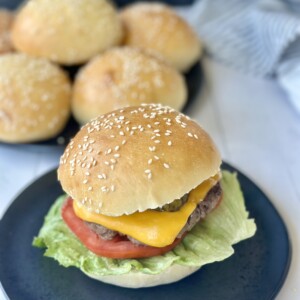
Fluffy Brioche Sourdough Burger Buns
There’s nothing quite like biting into a juicy burger only to have the whole experience elevated by the bun — pillowy soft, golden, slightly sweet, and just sturdy enough to handle all the fixings. These Fluffy Brioche Sourdough Burger Buns are exactly that.
Equipment
- Stand mixer with a dough hook optional
- Mixing Bowl for proofing
- Bench scraper
- Baking sheets
- Parchment paper or silicone mats
- Pastry Brush or paper towel for egg wash
- Digital Food Thermometer
- Plastic wrap or damp towel
Ingredients
Dough:
Wet Ingredients:
- 3/4 cup (200g) bubbly active sourdough starter 100% hydration
- 3/4 cup + 3 Tablespoons (190g) whole milk warmed to 80 degrees
- 1/4 cup + 1 Tablespoon (70g) water warmed to 80 degrees
- 1 Tablespoon (25g) honey
- 1/4 cup (50g) granulated white sugar
- 1 (50g) egg room temperature
- 2 teaspoons (10g) olive oil
- 1/4 cup (57g) unsalted butter, softened
Dry Ingredients:
- 4 1/4 cups (550g) bread flour or all-purpose flour
- 1 1/2 teaspoon (10g) sea salt
Garnish (optional):
- 1 Tablespoon sesame seeds
Instructions
Instructions:
Make The Dough:
- Warm milk and water in a small saucepan or microwave to reach 80 F. Don't overheat or starter will be killed when adding it to dough.3/4 cup + 3 Tablespoons (190g) whole milk, 1/4 cup + 1 Tablespoon (70g) water
- In a large mixing bowl (or stand mixer bowl), combine the active sourdough starter, milk, water, raw honey, sugar, egg, and olive oil.3/4 cup (200g) bubbly active sourdough starter, 1 Tablespoon (25g) honey, 1/4 cup (50g) granulated white sugar, 1 (50g) egg, 2 teaspoons (10g) olive oil
- Whisk until mixture is pale and fully emulsified.
- Add bread flour and salt. Stir until a shaggy dough forms. It should be slightly sticky but cohesive.4 1/4 cups (550g) bread flour, 1 1/2 teaspoon (10g) sea salt
- Add 1/4 cup softened butter into dough in 1 Tablespoon pats. Knead butter into dough slowly with mixer set on low fitted with a dough hook, or by hand for 8-10 minutes. Dough should be smooth and elastic.1/4 cup (57g) unsalted butter, softened
- Check for the windowpane test — stretch a small piece and see if it forms a thin, see-through membrane. This means your gluten is strong and ready.
- Tip: If sticky, avoid adding more flour. Instead, wet your hands or give the dough a short rest before continuing.
Bulk Fermentation:
- Transfer dough to a lightly greased bowl or container and loosely cover. Perform 1 set of stretch-and-folds at the 1-hour mark to build strength.
- Cover and ferment at 74–78°F for 6-8 hours, or until nearly doubled.
- Cold Fermentation (Optional): At this point, you have the option to shape and bake the buns the same-day, or you can cover well and transfer dough to refrigerator for overnight cold ferment. This step will improve gluten breakdown but can be skipped if desired.
Shape Buns:
- If dough was refrigerated overnight, remove from refrigerator and allow to rest on counter 30 minutes to warm. If you did not refrigerate dough, you can skip this step.
- Turn dough out onto a lightly floured or oiled surface. Divide into 8 equal portions (about 150g each).
- Let rest 10–15 minutes to relax gluten. Then shape each into a taut ball by cupping your hand and rolling it on the counter in a circular motion.
- Transfer to a parchment or silicone mat lined baking sheet, spacing evenly. I usually do 4-6 buns per baking sheet. Cover buns with a damp lint-free towel or oiled plastic wrap for final proof.
Final Proof:
- Let buns proof at room temp for 2–3 hours, or until buns are noticeably puffy and pass the poke test (a gentle press leaves a slow-filling dent).
- Beat 1 egg yolk with 2 Tablespoons of water in a small bowl.
- Brush buns with egg wash using a pastry brush or a paper towel. If using the paper towel method, just dip in egg mixture and brush all over the buns. This avoids an eggy rim around the base of the buns.
- Sprinkle buns with sesame seeds if desired.1 Tablespoon sesame seeds
Bake Buns:
- Preheat oven to 375°F (190°C).
- Bake for 20-24 minutes, rotating halfway through. Internal temp should reach 195–200°F. The tops should be deeply golden.
- Cool on a wire rack at least 20 minutes before slicing.
Notes
How to Store:
You can, but your buns may be slightly less chewy and structured. Stick with bread flour for best results.
Yes! Once completely cooled, freeze in an airtight bag for up to 2 months. Thaw and toast before serving.
No — it’s optional! Cold proofing develops deeper flavor, improve digestibility, and can be more convenient, but the same-day method works perfectly too.
They may have over proofed or were under-kneaded. Check for a strong windowpane and proof until just doubled in size and puffy.
- Buns are best stored in airtight packaging at room temperature for 2-3 days.
- Freeze buns for up to 2 months in airtight container, gently thaw and reheat when ready to use.
FAQ's:
- Can I use all-purpose flour instead of bread flour?
- Can I freeze them?
- Do I have to do the cold proof?
- Why are my buns flat?
Tried this recipe?Let us know how it was!